Abstract
Magnetorheological fluids (MRFs) are functional fluids that exhibit rapid and reproducible rheological responses to external magnetic fields. MRFs have been used to develop haptic devices with fine haptic information for teleoperated surgical systems. To achieve this, we developed various compact MRF clutches for haptics and integrated them into a twin-driven MRF actuator (TD-MRA). Several types of TD-MRAs were developed in prior studies. This study used three sets of TD-MRAs to construct a haptic device with a delta-type linkage system that displays a three-dimensional (3D) force vector for users in virtual reality or teleoperation systems. We described the kinematic design of the linkage system based on the torque performance of the TD-MRA and evaluated the output force performance using an open-loop force controller. The haptic interface was designed to achieve greater than 2 N of output forces and a motion range of ±50 mm. Experimental results demonstrated an average error of 0.1 N, indicating that the open-loop controller performed effectively in all directions at the tested platform positions.
1. Introduction
Magnetorheological fluids (MRFs) [1] are functional fluids composed of ferromagnetic particles, medium oils, and various additives. Their rheological properties change rapidly, stably, and repeatedly in response to applied magnetic fields. The particles, which have diameters ranging from 1–10 μm, align along the magnetic fluxes created by the external magnetic field, forming clusters that generate resistance against the orthogonal flow. The change in the yield stress induced by the intensity of the external magnetic field was significantly greater than the effect of the viscosity of the base oil. The fundamental properties of MRFs have been extensively investigated, including the dynamic range of the MR effect across a wide range of temperatures and shear rates [2,3] and the response time of the MR effect with field input [4].
MRFs are also suitable materials for creating high-performance force feedback devices or haptic devices that feature low inertia, high back-drivability, and high torque for direct driving [5,6]. Several researchers have proposed and developed rotary-type MRF-based clutches (MRCs) [7,8] to enhance torque performance from both static and dynamic perspectives. Additionally, MRFs are employed to create back-drivable MRF-based actuators (MRAs) [9]. A combination of MRCs and conventional actuators has been constructed for clutch-driven MRAs [10], a promising approach for concurrently achieving low inertia and back-drivability [11]. Our previous study combined two sets of MRAs to form a twin-driven MRF actuator (TD-MRA) [12]. Although the first prototype exhibited a non-negligible torque ripple due to its structural compliance, the second prototype successfully reduced this issue through its redesigned structure [13]. Evaluation results showed that the coefficient of variance of the torque was reduced by half due to the structural redesign.
There are diverse examples of haptic device mechanisms. Serial link mechanisms are widely used in commercially available remotely controlled surgical robots [14] due to their broad range of motion. Conversely, parallel link mechanisms are utilized in surgical robots [15] and in commonly used haptic devices [16]. Despite their narrower range of motion, the high rigidity, position control accuracy, and low inertia of the output link make them suitable for high-performance haptic devices. The delta link mechanism [17,18] is a parallel link mechanism whose degrees of freedom (DOF) facilitate translational movements in three directions. The delta link mechanism is driven by three rotational inputs, making it compatible with rotational actuators such as the TD-MRA.
We developed a haptic device utilizing TD-MRA and a delta linkage based on the above discussion. We proposed this concept in our previous study [19] and evaluated the first prototype. However, the TD-MRA used in the first prototype exhibited a non-negligible torque ripple [12]. Owing to the limitations of the first prototype, its output force performance was not sufficiently evaluated. We developed a second prototype of the TD-MRA that successfully reduced torque ripple and enhanced torque performance. However, this second prototype was not used as a torque source for the haptic interface.
Therefore, one of the objectives of this study was to develop a second prototype of the haptic interface prototype using the second TD-MRA. The design process is discussed from the perspective of kinematic analysis. Additionally, an open-loop controller was designed based on the input-output characteristics of the TD-MRAs used in the haptic device, and its force output performance was experimentally evaluated.
2. Twin-Driven Magnetorheological Fluid Actuator
TD-MRA serves as a torque generator for haptic devices, characterized by its low inertia and wide dynamic range, making it ideal for specific types of haptic generators requiring fine haptic information. Two sets of lightweight MRCs (Figure 1) serve as high-performance torque transmitters in this structure. Each MRC consists of multilayered discs and output shafts, with MRF filling the space between these discs. The basic structure exhibits rotational symmetry, with double bearings holding the rotational shaft. A magnetic wire is wound and embedded into the magnetic core. The discs and magnetic core are made of iron, while the other components are made of nonmagnetic materials [13]. A commercially available MRF, 132DG (Lord Corp., Cary, NC, USA), was selected as the working material for the developed device, with its flow characteristics detailed in our previous article [19]. Regarding material selection, detailed information has been reported in [12]. In [12], we selected three commercially available magnetorheological fluids (i.e., 122EG, 132DG, and 140CG from Lord Corp.). The experimental results show that 132DG is the better material for force control from the viewpoint of response time and the dynamic range of the controllable force.
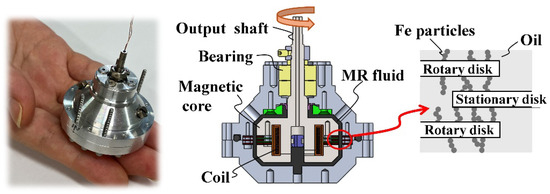
Figure 1.
Basic structure of multilayered disc-type MRF clutch for haptics.
Figure 2 illustrates the torque flow (a) and mechanical structure (b) of TD-MRA. In this system, an input motor generates a driving torque in only one direction (for example, CW) at a constant speed, while a pair of gears generates torques in both the clockwise (CW) and counterclockwise (CCW) directions. The compact MRF clutch for haptics (H-MRC) transmits torque precisely in each direction. The CW and CCW torque are combined using linkage or belt mechanisms, and the differential torque is delivered as output.
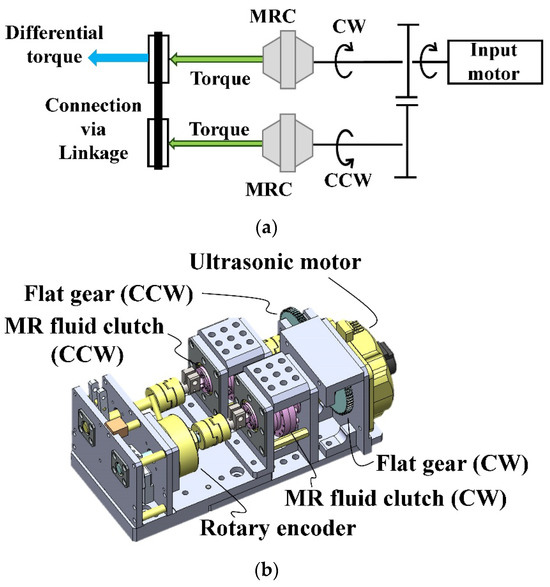
Figure 2.
Twin-driven Magnetorheological Fluid Actuator. (a) Torque flow structure. (b) Mechanical structure.
The H-MRC was mounted with Oldham couplings on both sides to mitigate misalignment, and the attachment walls were strengthened. We used a compact ultrasonic motor (PSM60S-ET, Piezo Sonic Corporation, Tokyo, Japan) for the input motor. Additionally, a hollow-type rotary encoder was inserted between the output linkage and the H-MRC. Specifications from references [13,19] are summarized in Table 1. One of the key performance metrics for actuators used in haptic devices is the torque response time. As shown in Table 1, the torque response time of the TD-MRA is approximately 10 ms. Additionally, the dynamic range of controllable torque is another critical metric. According to Table 1, the actuator has a dynamic range greater than 20, indicating a broad range of control. Based on these factors, we selected this actuator for our study.

Table 1.
Device specifications of Twin-driven Magnetorheological Fluid Actuator.
3. Design and Development of a Delta-Type Haptic Interface with MRA
3.1. Design
A haptic interface using the TD-MRAs was designed to generate three-dimensional (3D) forces and achieve low inertia, minimal friction in the off-state, and rapid response. A delta-type mechanism was adopted as the output linkage to achieve these requirements. Figure 3 illustrates the basic structure of the delta-type mechanism. This structure converts the three rotational inputs on the rotational axes (active joints in Figure 3) into three translational outputs on the output link. The basic concepts and design procedures are summarized in [17]. Our haptic interface was designed to achieve output forces greater than 2 N and a motion range of ±50 mm.
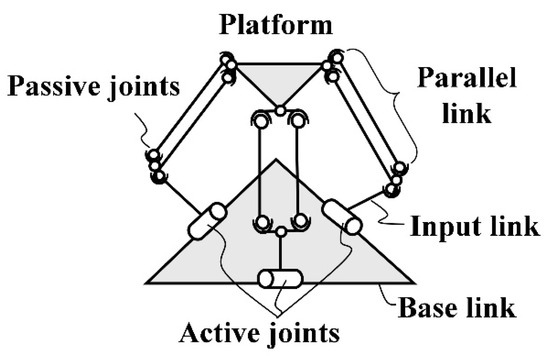
Figure 3.
Basic structure of delta linkage.
Figure 4 defines the design parameters and the coordinate system of the device. θ1–θ3 represent the rotational input of the delta mechanism, which corresponds to the output rotations of TD-MRAs. The lengths of the base link, platform, and input and parallel links are denoted as , , , and , respectively. The Jacobian Matrix, , of this mechanism is summarized as follows by considering its kinematics [17],

Figure 4.
Definitions of design parameters and coordination system, and position of output link on z-axis (x = y = 0).
In the above equations, the , , and are the position of the platform, and the other parameters are defined as follows,
To evaluate the operability of the manipulator, we calculated the static manipulability, , and explored the design parameters that satisfy the design goals.
Based on the analysis, we set mm, mm, mm, and mm. Figure 5 shows the analysis results, where the red, blue, and green points represent regions that are more than 75%, 50%, and 30% of the maximum operability, respectively. According to the design of the linkage system, the range of motion in a cylindrical area of 80 mm in radius and 100 mm in height was supported by more than 50% operability.
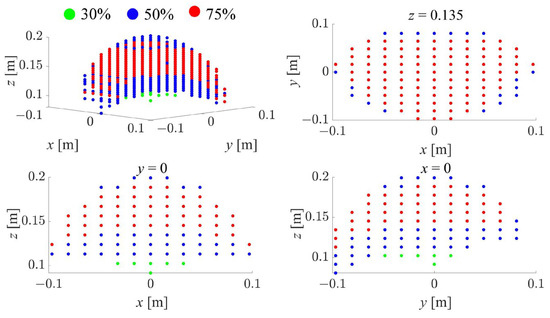
Figure 5.
Analysis results: operability of the designed linkage.
3.2. Development
Figure 6 shows the appearance of the developed haptic interface. This device comprises three sets of a second prototype of TD-MRAs [13], a delta mechanism made of 3D-printable carbon fiber reinforced plastic (CFRP), and a gripper providing three translational DOF.
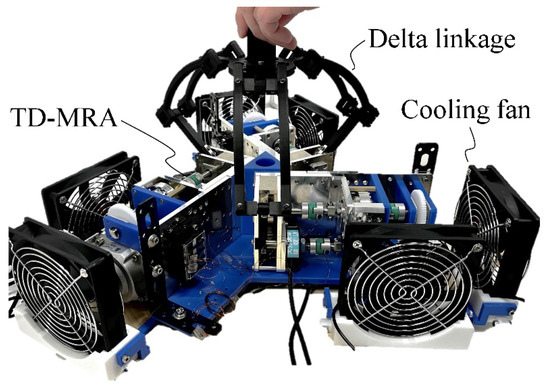
Figure 6.
Delta-type haptic device.
Table 2 outlines the specifications of the haptic interface. The output forces within the range of motion were calculated based on kinematic analysis, with the maximum torque of the TD-MRA. The results indicated output forces exceeding 2 N and 3 N in the vertical and horizontal directions, respectively.

Table 2.
Specifications of delta-type haptic device.
4. Performance Validation with Open-Loop Force Controller
4.1. Measurement Setup
A six-axis force–moment sensor (PFS055YA251G6, Leptrino, Nagano, Japan) was mounted on an aluminum frame and attached to the platform of the device. Figure 7 illustrates the signal flow of the measurement system. A personal computer was the main controller, and an NI PXIe-8821 (National Instruments, Austin, TX, USA) was used as the real-time controller. The devices communicated via local area network cables, and the sampling time of the NI PXIe-8821 was 1 ms. The D/A board (NI PXIe-6738, National Instruments, Austin, TX, USA) was inserted into the NI PXIe-8821 to output command values for controlling the ultrasonic motor and clutches. The force of the device was measured in real-time using the force-moment sensor. An A/D board (NI PXIe-6355, National Instruments, Austin, TX, USA) was also connected to the NI PXIe-8821 to read the output signal from the force-moment sensor, thereby measuring the output performance of the device.
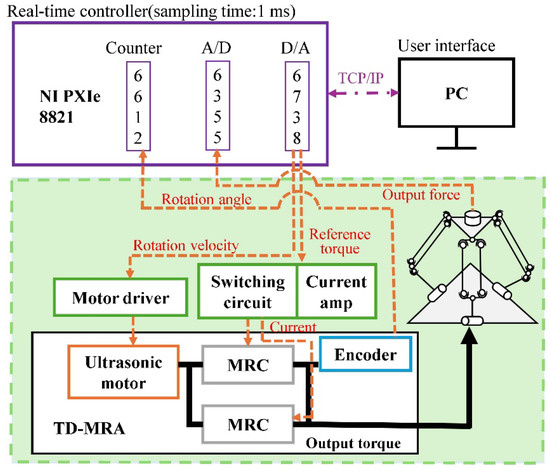
Figure 7.
Signal flow of the setup.
4.2. Design of the Open-Loop Controller
Three sets of TD-MRAs, No. 1–3, were used as torque drivers for the active joints of the delta link system. Each TD-MRA included two MRCs as torque transmitters on the motor-side (MS) and opposite-side (OS). To design the open-loop controller, the relationships between the input current and output torque for all the MRCs in the haptic device were preliminarily measured. Figure 8 shows the measurement results, where “MS1” indicates the motor-side MRC in No.1 TD-MRA. In the figures, the horizontal and vertical axes represent the current input and output torque, respectively. Third-order regression functions were calculated using the least mean square method. Each curve in these figures denotes the model curve, where “T” and “I” indicate the output torque and input current. These functions were used in the open-loop force controller of haptic devices.
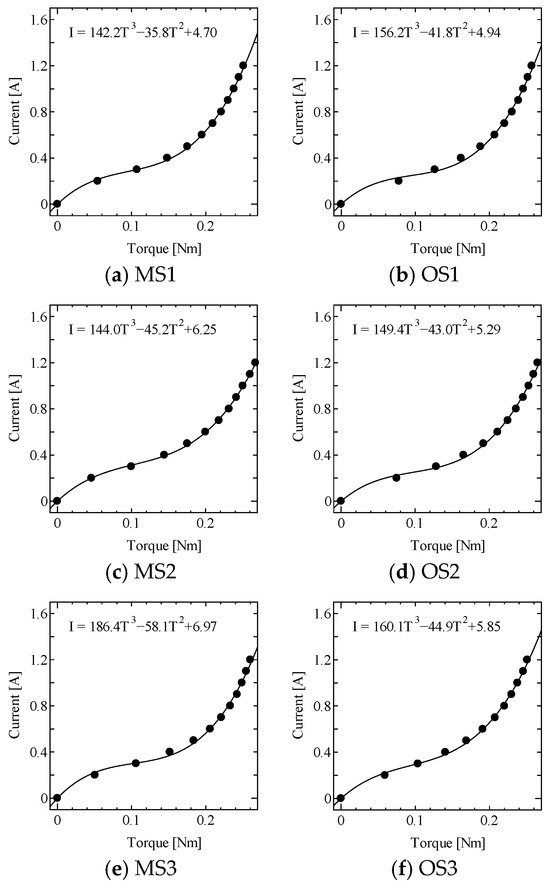
Figure 8.
Performance of TD-MRA (MS: motor-side, OS: opposite-side for No. 1–3) and nominal model of each axis.
Figure 9 shows the block diagram of the open-loop force controller. In the controller, the required 3D force vector () was first transformed into a torque vector (), whose three components (, , and ) were the output torques of the three TD-MRAs. The transposed matrix of the Jacobian Matrix (Equation (2)) was used as the transformation matrix. Furthermore, the required output torques were transformed into the corresponding input currents using the nominal models shown in Figure 8.
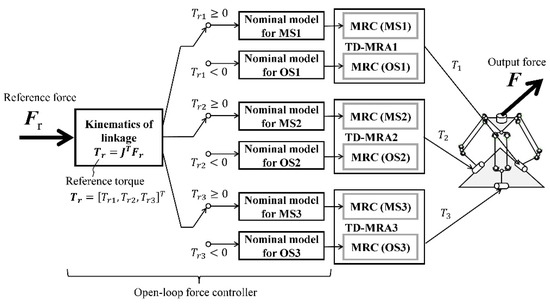
Figure 9.
Block-diagram of open-loop force controller.
4.3. Experimental Conditions
Experiments were conducted at five representative positions on the platform to investigate the torque performance of the developed device and the designed force controller. Table 3 lists the experimental positions, and Figure 4 shows the coordinate definition. P0 is located on the z-axis and is the most operational position of the device due to its high manipulability measure. P1–P4 are positions shifted along the x-z axes from P0 to observe the variation in force performance depending on the platform positions.

Table 3.
Measured positions.
The rotational speed of the ultrasonic motor in each TD-MRA was controlled at 60 rpm. The reference force ranged from −2 N to 2 N in each direction.
4.4. Results
Figure 10 shows the performance of the open-loop force control of the device at each platform position listed in Table 3. The horizontal and vertical axes denote the reference and measured forces, respectively. The circles, squares, and triangles represent the forces in the x, y, and z directions, respectively.
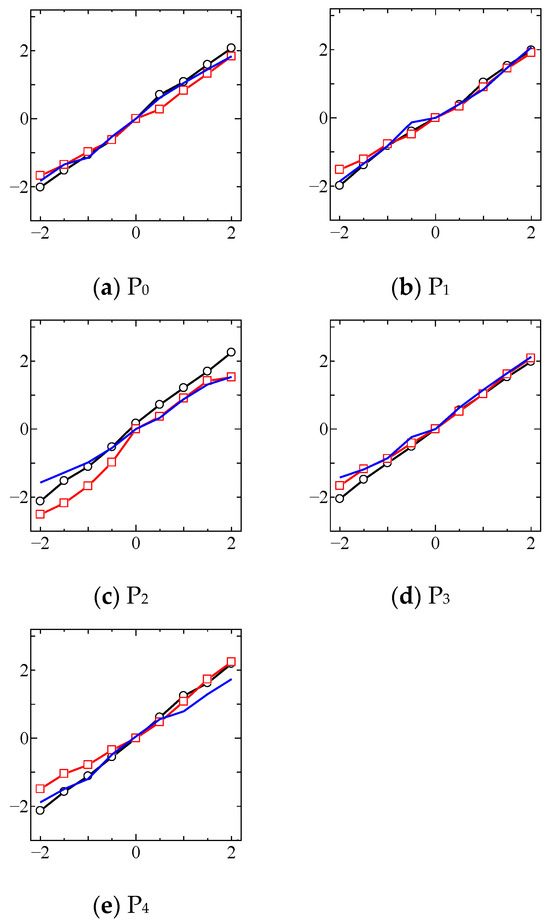
Figure 10.
Performance of open-loop force control.
4.5. Discussions
The experimental results show that the open-loop controller performed well in all directions at the investigated platform positions, although some degrees of error were observed. Table 4 lists the absolute average error of the output force in the three directions at the five positions. At P0, the average error was approximately 0.1 N, and the error in the direction of the y direction was relatively high. This trend was consistent at four positions. Overall, the errors in P2 were relatively high compared to those at other positions, with the average error doubling the total average. As shown in Figure 4, the input joint of the delta mechanism has three-fold rotational symmetry, which causes differences in the distribution of the output contributions for the actuators. For instance, the y-direction force is primarily generated by the rotational torque around joint 1. However, joint 1 torque does not contribute to the x-direction force. The experimental results indicated relatively large errors in the y-direction force, suggesting that the force control performances of MS2 and OS2 were lower. This study utilized an open-loop force controller based on a nominal model between the current input and output torque of the MRCs. Force disturbances, such as friction in the rotational joints of the delta linkage, may have impacted performance. A potential solution is to use model-based estimators, such as disturbance observers [20].

Table 4.
Absolute average error of output force.
The MRF exhibits anisotropic microstructures, characterized by clusters of magnetic particles, particularly under a high magnetic field. These microstructures induce changes in rheological properties, as discussed in the introduction. Although the structure undergoes dynamic and complex transformations at the microscale, its macroscale flow characteristics demonstrate high repeatability, as shown in Figure 10. However, these results are subject to certain limitations. In this experiment, a force–moment sensor was mounted on an aluminum frame and attached to the platform of the device. Due to this limitation, only the static force performance, in which the platform does not move, was evaluated. The performance under the dynamic state of the platform should be discussed in the future. Despite the limitation, the results of this research can be applied to teleoperated surgical support robots, where the delicate presentation of reaction forces is effective.
5. Conclusions
In this study, a haptic device was developed using a second prototype of the TD-MRA. The device incorporated a delta-type link mechanism, with three TD-MRA sets connected to generate a 3D translational force output. The kinematic calculations were conducted to design the link system, which achieved output forces exceeding 2 N and a range of motion of ±50 mm. An open-loop force controller was designed and experimentally evaluated to verify its performance. The experimental results indicated average errors of approximately 0.1 N, demonstrating that the open-loop controller performed effectively in all directions at the tested platform positions.
Author Contributions
Conceptualization, T.K.; methodology, T.K.; investigation, T.K. and A.I.; mechanical design, A.I. and I.A.; writing—original draft preparation, T.K.; writing—review and editing, T.K.; visualization, T.K. and A.I.; supervision, T.K.; project administration, T.K.; and funding acquisition, T.K. All authors have read and agreed to the published version of the manuscript.
Funding
This research was partially supported by Kurata Grants from the Hitachi Global Foundation (1555), and the Fund Program for Creating Research-based Startups from Academia (JPMJSF23DW).
Data Availability Statement
Data are contained within the article.
Conflicts of Interest
The authors declare no conflicts of interest.
References
- Carlson, J.D.; Jolly, M.R. MR fluid, foam and elastomer devices. Mechatronics 2000, 10, 555–569. [Google Scholar] [CrossRef]
- Wang, X.; Gordaninejad, F. Study of magnetorheological fluids at high shear rates. Rheol. Acta 2006, 45, 899–908. [Google Scholar] [CrossRef]
- Becnel, A.C.; Sherman, S.; Hu, W.; Wereley, N.M. Nondimensional scaling of magnetorheological rotary shear mode devices using the Mason number. J. Magn. Magn. Mater. 2015, 380, 90–97. [Google Scholar] [CrossRef]
- Goncalves, F.D.; Carlson, J.D. Investigating the time dependence of the MR effect. Int. J. Mod. Phys. B 2007, 21, 4832–4840. [Google Scholar] [CrossRef]
- Scilingo, E.; Bicchi, A.; De Rossi, D.; Scotto, A. A magnetorheological fluid as a haptic display to replicate perceived biological tissues compliance. In Proceedings of the 1st Annual International IEEE-EMBS Special Topic Conference on Microtechnologies in Medicine and Biology. Proceedings (Cat. No.00EX451), Lyon, France, 12–14 October 2000; pp. 229–233. [Google Scholar]
- Bicchi, A.; Raugi, M.; Rizzo, R.; Sgambelluri, N. Analysis and design of an electromagnetic system for the characterization of magneto-rheological fluids for haptic interfaces. IEEE Trans. Magn. 2005, 41, 1876–1879. [Google Scholar] [CrossRef]
- Kikuchi, T.; Otsuki, K.; Furusho, J.; Abe, H.; Noma, J.; Naito, M.; Lauzier, N. Development of compact MR fluid clutch for human-friendly actuator. Adv. Robot. 2010, 24, 1489–1502. [Google Scholar] [CrossRef]
- Liu, G.; Gao, F.; Wang, D.; Liao, W.-H. Medical applications of magnetorheological fluid: A systematic review. Smart Mater. Struct. 2022, 31, 043002. [Google Scholar] [CrossRef]
- Zhang, P.; Kamezaki, M.; Otsuki, K.; He, S.; He, Z.; Dominguez, G.A.; Sugano, S. Development and evaluation of a backdrivable vane-type rotary actuator using magnetorheological fluids. IEEE/ASME Trans. Mechatron. 2022, 27, 4863–4873. [Google Scholar] [CrossRef]
- Najmaei, N.; Asadian, A.; Kermani, M.R.; Patel, R.V. Magneto-rheological actuators for haptic devices: Design, modeling, control, and validation of a prototype clutch. In Proceedings of the 2015 IEEE International Conference on Robotics and Automation (ICRA), Seattle, WA, USA, 26–30 May 2015; pp. 207–212. [Google Scholar]
- Ishida, T.; Takanishi, A. A Robot Actuator Development With High Backdrivability. In Proceedings of the 2006 IEEE Conference on Robotics, Automation and Mechatronics, Bangkok, Thailand, 1–3 June 2006; pp. 1–6. [Google Scholar]
- Kikuchi, T.; Abe, I.; Nagata, T.; Yamaguchi, A.; Takano, T. Twin-driven actuator with multi-layered disc MR fluid clutches for haptics. J. Intell. Mater. Syst. Struct. 2020, 32, 1326–1335. [Google Scholar] [CrossRef]
- Kikuchi, T.; Ikeda, A.; Matsushita, R.; Abe, I. Development of second prototype of twin-driven magnetorheological fluid actuator for haptic device. Micromachines 2024, 15, 1184. [Google Scholar] [CrossRef] [PubMed]
- Simorov, A.; Otte, R.S.; Kopietz, C.M.; Oleynikov, D. Review of surgical robotics user interface: What is the best way to control robotic surgery? Surg. Endosc. 2012, 26, 2117–2125. [Google Scholar] [CrossRef] [PubMed]
- Song, B.-K.; Oh, J.-S.; Choi, S.-B. Design of a new 4-dof haptic master featuring magnetorheological fluid. Adv. Mech. Eng. 2014, 6, 843498. [Google Scholar] [CrossRef]
- Siciliano, B.; Khatib, O. Handbook of Robotics, 2nd ed.; Section 43, Telerobotics; Springer: Berlin/Heidelberg, Germany, 2016; pp. 1085–1108. [Google Scholar]
- Williams, R.L., II. The Delta Parallel Robot: Kinematics Solutions. Internet Publication. 2016. Available online: https://people.ohio.edu/williams/html/PDF/DeltaKin.pdf (accessed on 22 January 2025).
- Pierrot, F.; Reynaud, C.; Fournier, A. DELTA: A simple and efficient parallel robot. Robotica 1990, 8, 105–109. [Google Scholar] [CrossRef]
- Ikeda, A.; Takano, T.; Abe, I.; Kikuchi, T.; Mimata, H.; Inomata, M. Kinematic analysis and evaluation of delta-type haptic device using twin-driven MR fluid actuator. In Proceedings of the 2023 IEEE/SICE International Symposium on System Integration (SII), Atlanta, GA, USA, 17–20 January 2023; pp. 76–81. [Google Scholar]
- Chen, W.-H. Disturbance Observer Based Control for Nonlinear Systems. IEEE/ASME Trans. Mechatronics 2004, 9, 706–710. [Google Scholar] [CrossRef]
Disclaimer/Publisher’s Note: The statements, opinions and data contained in all publications are solely those of the individual author(s) and contributor(s) and not of MDPI and/or the editor(s). MDPI and/or the editor(s) disclaim responsibility for any injury to people or property resulting from any ideas, methods, instructions or products referred to in the content. |
© 2025 by the authors. Licensee MDPI, Basel, Switzerland. This article is an open access article distributed under the terms and conditions of the Creative Commons Attribution (CC BY) license (https://creativecommons.org/licenses/by/4.0/).